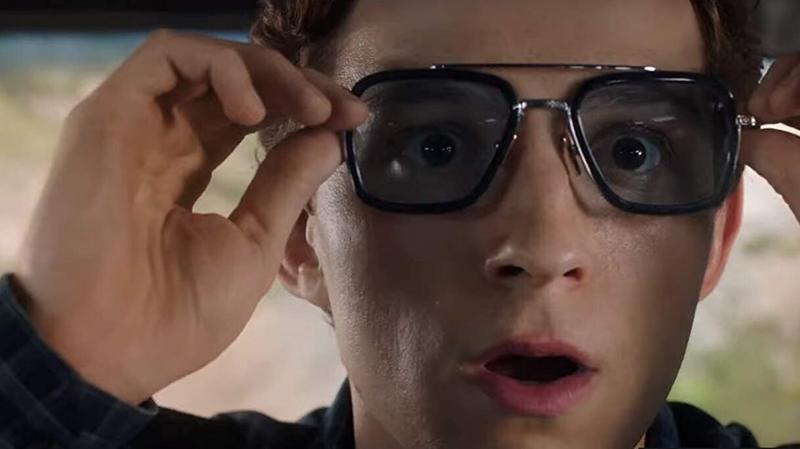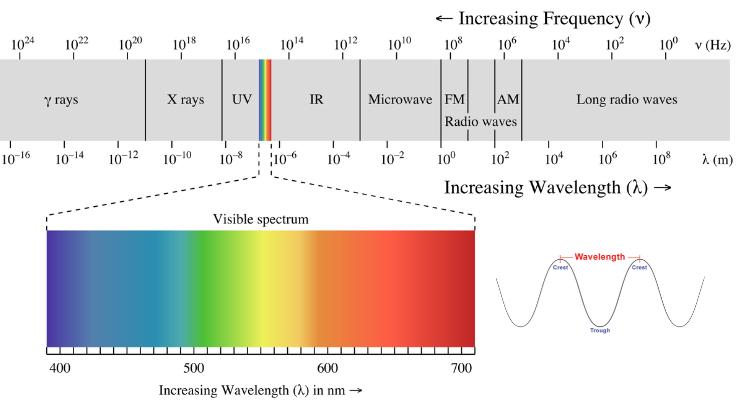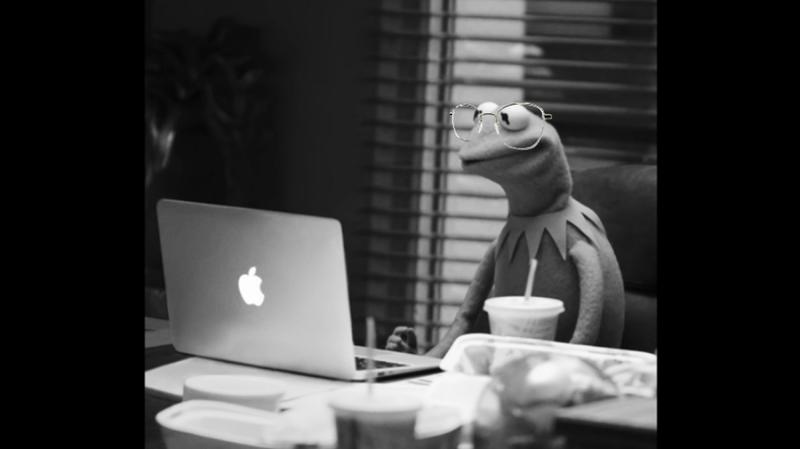Does Windows 10 Have Setting For Blue Light Filter

For embankment-goers, experts always recommend a healthy coating of sunscreen to protect the skin from those pesky ultraviolet (UV) rays. But sunlight contains more than just UV low-cal. In fact, it's made upwardly of crimson, green, yellow, blueish and orange light rays, which combine to create "white calorie-free" (a.grand.a. sunlight). If you lot haven't saturday through a high school chemistry class in a while, no worries. We'll break down the of import stuff — without getting likewise scientific.
Equally the name suggests, visible light tin can be seen past the human center, and each ray reflects a detail color. The color of a given ray depends on said ray's wavelength (run across the graphic below) — or the altitude between successive crests of a wave. (Side note: This means that objects become their colors through the wavelength of the light that is reflected from them. Trust us — don't think too difficult virtually it. Things become trippy.)
Some other important relationship to note is that of wavelengths and energy: The longer the distance between waves, the less energy a ray has to offering. Think of information technology this mode — if the wave crests are farther autonomously, they're a bit lackadaisical, but if the crests come in rapid succession, there'south a frenzy of free energy at that place. All of this means rays on the ruddy end of the visible light spectrum have longer wavelengths and less energy, whereas rays on the blue cease have shorter wavelengths and more free energy.
UV rays, which aren't on the visible light spectrum, surpass blue light in terms of how much energy they contain. That incredible amount of free energy is how those rays are able to create a concrete change, like tanning (or called-for) i's peel. In moderation ultraviolet radiation tin be skilful for us (think vitamin D!), but, on the other hand, it tin can also produce some devastating effects (think sunburn and snow blindness!).
How Does Bluish Lite Affect 1's Wellness?
Simply what most blue calorie-free — these visible rays that are a few notches below harmful UV rays? Well, approximately one-tertiary of all visible light is considered high-energy visible (HEV) blueish light. Blue light is literally why the heaven appears bluish: These rays scatter more easily than other visible rays of calorie-free when they strike the atmosphere's air and h2o molecules — and all that scattering makes the sky that vibrant blue.

There'south no escaping it, specially because daylight is our main source of blueish light. But information technology's not all bad: Experiencing blue calorie-free during the daytime helps regulate one's circadian rhythms, makes one more alert, elevates cognitive function, promotes good recall and is fifty-fifty used in light therapy to treat seasonal affective disorder (SAD). All the same, human-fabricated objects — including LED lights and display screens on apartment-screen TVs, computers and smartphones — emit blue light besides. Although these devices only emit a fraction of the blue light the dominicus emits, researchers and doctors take still voiced concerns virtually patients' excessive screen time in recent years.
Perhaps surprisingly, the human center is pretty nifty at protecting the retina from UV rays, but blue low-cal is a different story. Virtually all of it penetrates the lite-sensitive retina, causing impairment that approximates macular degeneration — a condition that tin atomic number 82 to vision loss.
In addition to potentially harming your eyes over time, blueish lite can also lead to heart strain. If you've ever concluded up with a wicked headache after staring intensely at an Excel spreadsheet for hours, you're probably familiar with that detail discomfort. When we noted how blue light contributes to the sky looking blue, nosotros mentioned that this is then because of how bluish calorie-free scatters. Well, co-ordinate to All Most Vision, this same scattering of the blue light that emanates from screens makes for "unfocused visual 'noise' [that] reduces contrast and can contribute to digital eye strain."
If you don't suffer from eye strain due to increased exposure to blue light, these inescapable rays may however have adverse furnishings on your health. Whatsoever sort of light — regardless of where information technology falls on the spectrum — tin can suppress the man body's ability to release melatonin, the hormone that regulates sleep cycles. However, information technology's thought that blue light quashes melatonin secretion even more than than other hues exercise. Researchers at Harvard Academy compared the effects of blue and green light exposure and establish that "blue light suppresses melatonin [secretion] for near twice every bit long as the greenish light and shifted circadian rhythms by twice as much."
It's a Blue, Bluish Globe
BluTech, a visitor that manufactures special blue light-filtering lenses, reports that "43% of adults have a job that requires prolonged use of a tablet or computer" — and that'due south just while said adults are on the clock. Factor in all that time we spend online, texting and marathoning Netflix, and adults spend roughly 12 hours a day looking at screens and taking in blue low-cal. So, how tin you mitigate the harmful furnishings of prolonged exposure to blue calorie-free?

Well, these blueish light-filtering lenses are condign all the rage. Although not every bit ubiquitous equally Away suitcases or Blue Frock commercials, you've probably heard commercials for blue low-cal-filtering specs from Felix Gray or Warby Parker on your favorite podcast or radio talk show. Felix Gray glasses, for example, pride themselves on having a blue lite-filtering fabric embedded within, which the company says will adjourn middle strain, headaches and sleep disruption.
If you're not into the glasses road, experts recommend taking screen breaks, both at work and at home; keeping screens clean to reduce glare and further eye strain; changing your abrasive white display background to something less vivid; blinking more often; and avoiding screens for at least 30 minutes to an hour before bed because screens stimulate your brain. Possibly it'southward time to trade that fancy blue light-emitting tablet for a Kindle Paperwhite, or, yous know, a good old-fashioned book.
Does Windows 10 Have Setting For Blue Light Filter,
Source: https://www.faqtoids.com/health/blue-light-facts?utm_content=params%3Ao%3D740006%26ad%3DdirN%26qo%3DserpIndex
Posted by: jorgensenbouselt.blogspot.com


0 Response to "Does Windows 10 Have Setting For Blue Light Filter"
Post a Comment